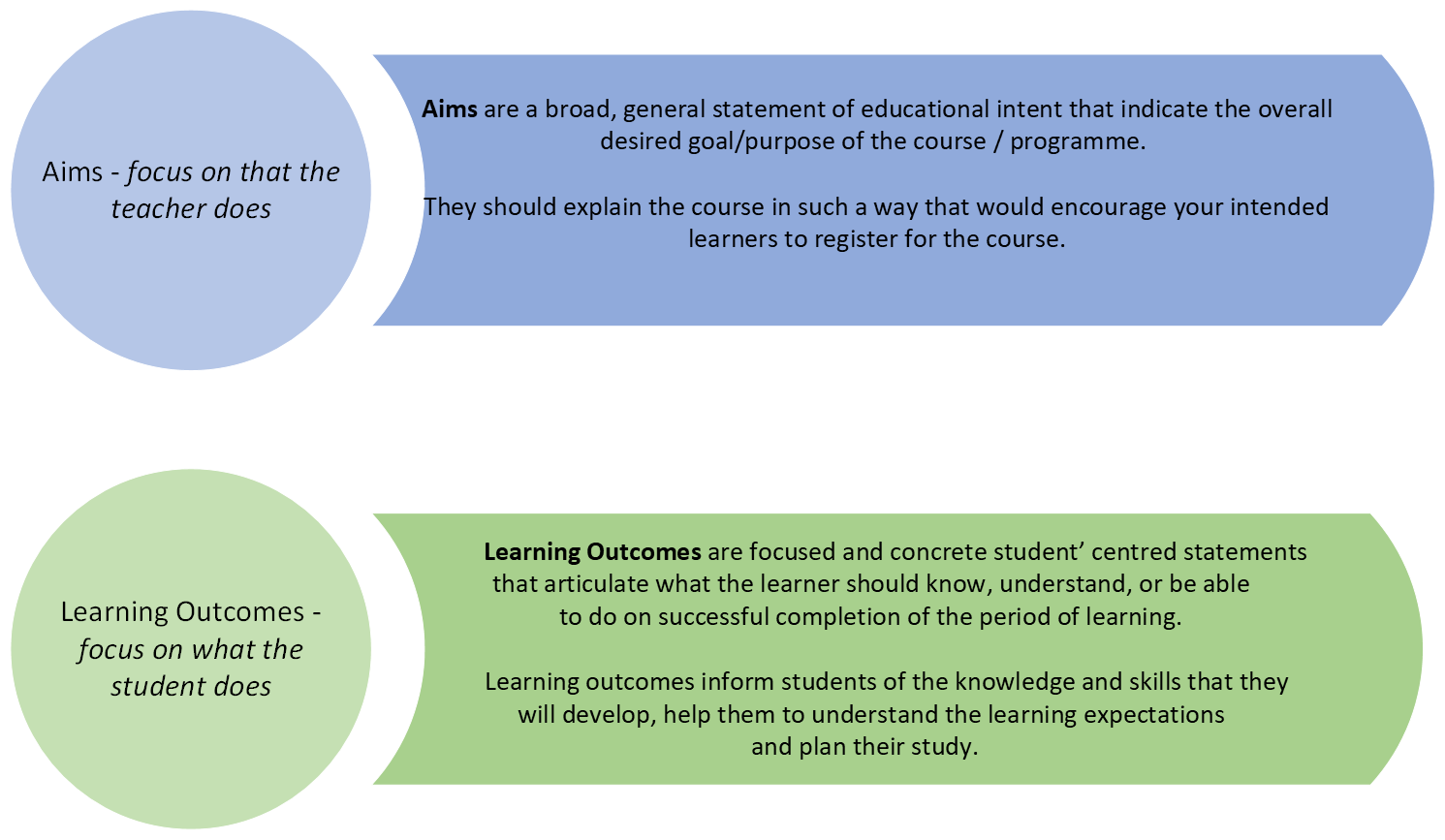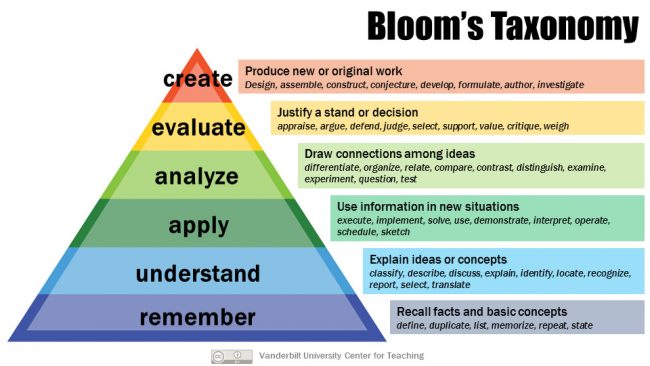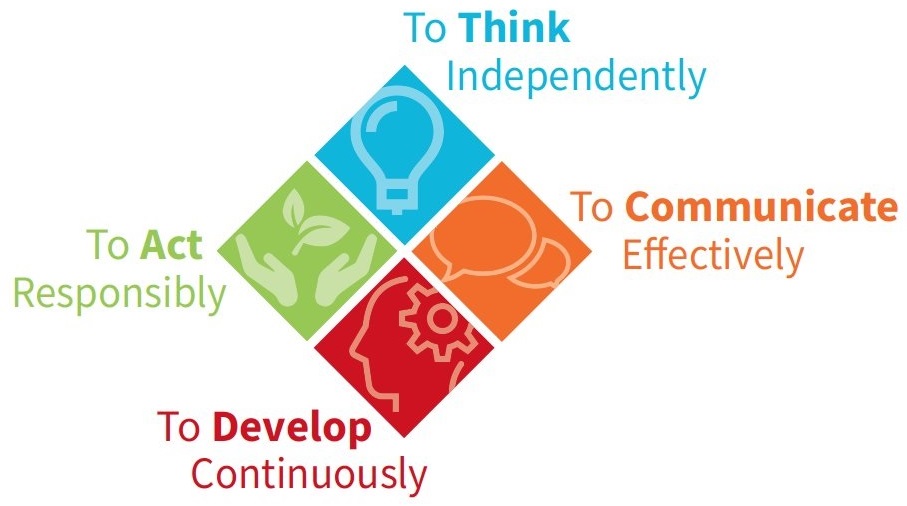Aims and Learning Outcomes
In order to ensure curriculum alignment it is important to start by defining the aims and learning outcomes of the programme or module. The information contained in this page will help you write effective aims and learning outcomes.
The graphic below indicates the function of the aims and learning outcomes of a programme or module.

Writing aims – what needs to be considered
- What is the ‘need’ for the module/programme?
- Who is likely to take this module/programme?
- How will it be appropriate to their needs?
- What are you trying to achieve with this module/programme?
- What are its key features?
Writing learning outcomes – what needs to be considered
- Are the learning outcomes, ‘outcomes’, as opposed to a list of syllabus aims or objectives?
- Are they written in the future tense, clear and concise?
- Do they use verbs that can be assessed/measured?
- Are all of these learning outcomes essential?
- Are they limited in number?
- Do they support the relevant knowledge, skills and competencies associated with the NFQ level of the module/programme?
Having clear learning outcomes will help determine the appropriate assessments and the teaching and learning strategies for the programme and/or module.
For more information see:
-
Linking assessment methods with learning outcomes on our assessment pages.
-
Linking teaching strategies with learning outcomes on our teaching strategies page.
The sections below contain more detailed information on how to write effective learning outcomes, both at programme and module level. Examples are also presented.
Click on the links below to open the sections.
Learning Outcomes - Using taxonomies
It can be useful to look at taxonomies when constructing learning outcomes. Perhaps the most influential taxonomy is Bloom’s Taxonomy of Educational Objectives which categorises learning into three domains: cognitive, affective and psychomotor:
- The cognitive domain includes recall, recognition of knowledge and the development of intellectual skills/abilities.
- The affective domain incorporates emotion, feeling and character.
- The psychomotor domain concerns physical movement and coordination.
Learning outcomes in higher education are most commonly related to the cognitive domain. Bloom’s Taxonomy provides an accessible framework for conceptualising learning outcomes, based on six levels of learning associated with the cognitive domain. The image below lists an accompanying suite of appropriate verbs for articulating learning outcomes at each of the levels. Remember to use assessable verbs. For example, verbs such as ‘appreciate’ or ‘understand’ are more difficult to measure by assessment than ‘to critically evaluate’ or ‘to present’.

Figure 1. Bloom’s Taxonomy. From Vanderbilt University Center for Teaching (https://commons.wikimedia.org/wiki/File:Blooms-Taxonomy-650x366.jpg), added labels by Academic Practice, https://creativecommons.org/licenses/by-sa/4.0/legalcode.
Programme Outcomes – Encompassing discipline specific and Trinity’s graduate attributes
Programmatic learning outcomes focus on the high-level knowledge, skills, and competencies students should acquire on completion of a whole programme, and therefore:
- Are more complex with a broader scope than module level learning outcomes.
- Encompass discipline specific and/or professional attributes.
- Reflect the appropriate international level standard as with the appropriate NFQ level.
- Incorporate the Trinity Graduate attributes as indicated below.
- Embedding Trinity Graduate Attributes in the Curriculum. PDF

Trinity’s graduate attributes were specifically formulated as desirable outcomes consonant with the achievements of all Trinity graduates; the aim of these outcomes is to represent an engagement with ‘wicked competencies’, e.g. achievements that take time to develop and resist measurement-based approaches to assessment. As a result, programme outcomes should be formulated in such a way that they enable students to ‘do’ all four attributes by the end of their programme of study.
Example of a programme aim and associated learning outcomes
| Course Title | Master in Education Studies (Primary Mathematics Education) Online |
| Course Group | PG Taught |
| Proposed degree award title | Master in Education Studies /Postgraduate Diploma (Primary Mathematics Education) (exit only) |
| Award type/Level of NFQ | NFQ level 9 |
| ECTS Credit volume and value of student effort hours per 1 ECTS | 90 ECTS 25 student effort hours per 1 ECTS credit |
| A web-based narrative for the course (and/or individual strands where relevant) with interactive links for the Academic Registry: | |
| The Master in Education Studies (Primary Mathematics Education) is an innovative and unique Masters course that draws on research and practice in primary mathematics education in Ireland and further afield in order to prepare future leaders of primary mathematics. Few opportunities currently exist in Ireland for students to study for a dedicated and online Masters degree where all the credits are awarded for study and research in primary mathematics education. This course aims to address this gap. The course is framed to provide clear interaction between theory and practice. A key feature of the course is to build an online community among participants, with a focus on analysing and implementing primary mathematics teaching. | |
| Learning outcomes at the programme level | |
| (For a programme you may have up to 10 or 12 Learning outcomes) | |
| CLO1. Demonstrate strong mathematical knowledge for teaching primary mathematics curriculum topics. | |
| CLO2. Use research and policy frameworks to evaluate primary mathematics teaching. | |
| CLO3. Critique and conduct research in primary mathematics education. | |
| CLO4. Design and evaluate teacher education courses or course components for pre-service and in-service teachers. | |
| CLO5. Design and implement primary mathematics education that is inclusive of all children regardless of linguistic, cultural or socio-economic backgrounds and different learning styles. | |
| CLO6. Lead the development of primary mathematics education policy, practice and research within and beyond their schools. | |
| CLO7. Model innovative teaching strategies and disseminate insights and evidence-based practice in primary mathematics education. | |
| CLO8. Demonstrate skills necessary to respond to technological, social, pedagogical and policy changes in education and mathematics education specifically. | |
| CLO9. Demonstrate specialist research knowledge and associated skills in primary mathematics pedagogy, including the completion of a dissertation. | |
| CLO10. Use their dissertation research to critically evaluate issues related to the teaching and learning of primary mathematics. | |
Example of a module aim and associated learning outcomes
| Module Title | Advanced Spatial Analysis using GIS |
| NFQ Level | 9 |
| ECTS | 5 Credits |
| Module Aims | The aim of this module is to give participants the skills to produce high-quality maps and to analyse and use spatial data using the widely used open-source software QGIS. |
| Module learning outcomes (Approx. 5 for a 5 ECTS credit module |
On successful completion of this module, learners will be able to: LO1. Investigate and solve Spatial Analysis problems by applying the latest interdisciplinary approaches. LO2. Communicate effectively in technical and scientific writing, and present scientific/technical ideas concisely to a technical audience that may not be expert in the specific domain of the presentation. O3. Critically select and implement a technical solution that best addresses a spatial analysis problem. LO4. Identify and use appropriate mathematical methods, numerical techniques and GIS tools for application to new and ill-defined spatial analysis problems |
Key Takeaways
- Aims are a short statement on the educational intent of the programme or module that reflect the needs of the intended learners
- Learning Outcomes describe what the students should know, understand, or be able to do at the end of the learning period
- Learning Outcomes will be used to inform the design of the teaching, learning and assessments strategies used in the programme or module design.
- - Focus is on what the teacher does
-
- Focus is on what the student does
- - Should be written at the appropriate level of qualification using assessable verbs
-
- Taxonomies such as Blooms’ can be useful for selecting appropriate verbs

